Restraint Practices in Mental Health
VerifiedAdded on 2022/09/08
|11
|3181
|38
AI Summary
Contribute Materials
Your contribution can guide someone’s learning journey. Share your
documents today.
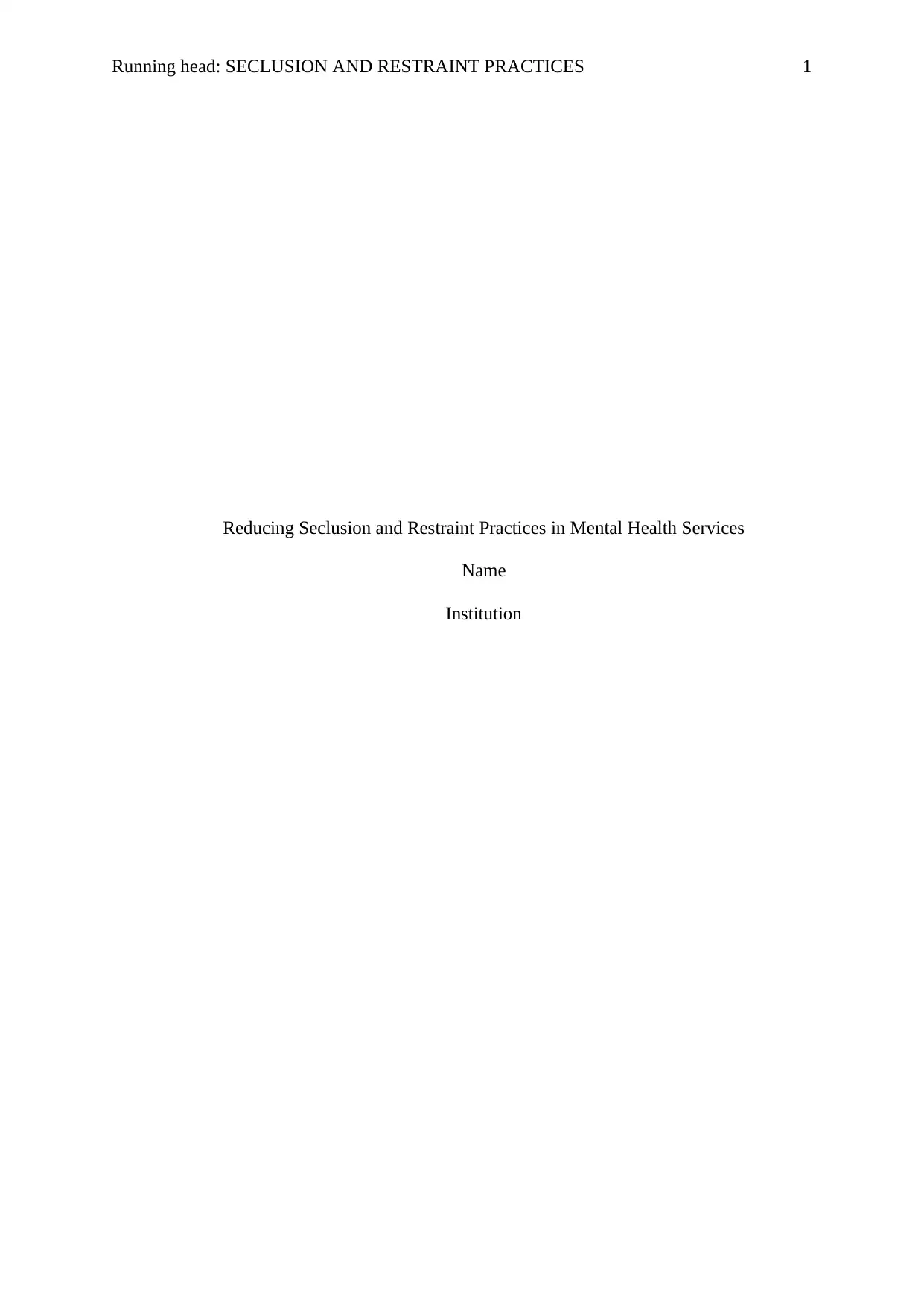
Running head: SECLUSION AND RESTRAINT PRACTICES 1
Reducing Seclusion and Restraint Practices in Mental Health Services
Name
Institution
Reducing Seclusion and Restraint Practices in Mental Health Services
Name
Institution
Secure Best Marks with AI Grader
Need help grading? Try our AI Grader for instant feedback on your assignments.

SECLUSION AND RESTRAINT PRACTICES 2
Reducing Seclusion and Restraint Practices in Australian Mental Health Services
Introduction
Involuntary consumer incarceration in a room that can disallow a consumer from
physically exiting is referred to as seclusion. the consumer is physically barred from leaving.
Patients that exhibit challenging behaviors such as violence, aggression or self-destruction
(RANZCP, 2016). Restrained refers to any manual manner, physical or mechanical
equipment, material, or device that is used to immobilize or minimize the ability of a
consumer of mental health services to move his or her arms, legs, body, or head freely
(RANZCP, 2016). Chemical restraints comprise using chemicals or chemical processes such
as the use of sedative medication. On some occasions, a drug, which is not part of the normal
medication a consumer’s illness, may be used for restraining a patient, and manage his or her
challenging habit or restricting their liberty to move around. Also, emotional seclusion
involves the use of threats and coercion.
Either seclusion and restraint may be applied in the case where mild coercive strategies
have been deemed ineffective to keep the consumer, or healthcare professional from injury.
The two methods are differentiated from other forms of medical treatment by intention.
Application of seclusion and restraint has raised arguments as they are associated with misuse
and adverse consequences to the patient besides the caregiver. Therefore, in recent years, to
avert the impacts related to seclusion and restraint, there has been a need for registered nurse-
consumer centered approaches to decrease restraining interventions in Australian psychiatric
care (Hercelinskyj & Alexander, 2019)
Impacts of Seclusion and Restraint to Consumers and Healthcare Professionals
Application of restraint and seclusion in Australia is increasing. For instance, in 2018-
19, 11944 mental cases were secluded in national psychiatric facilities and signifies about 7.3
cases of seclusion per a thousand days spent in wards. Relative to 2017-18 data, these rates
Reducing Seclusion and Restraint Practices in Australian Mental Health Services
Introduction
Involuntary consumer incarceration in a room that can disallow a consumer from
physically exiting is referred to as seclusion. the consumer is physically barred from leaving.
Patients that exhibit challenging behaviors such as violence, aggression or self-destruction
(RANZCP, 2016). Restrained refers to any manual manner, physical or mechanical
equipment, material, or device that is used to immobilize or minimize the ability of a
consumer of mental health services to move his or her arms, legs, body, or head freely
(RANZCP, 2016). Chemical restraints comprise using chemicals or chemical processes such
as the use of sedative medication. On some occasions, a drug, which is not part of the normal
medication a consumer’s illness, may be used for restraining a patient, and manage his or her
challenging habit or restricting their liberty to move around. Also, emotional seclusion
involves the use of threats and coercion.
Either seclusion and restraint may be applied in the case where mild coercive strategies
have been deemed ineffective to keep the consumer, or healthcare professional from injury.
The two methods are differentiated from other forms of medical treatment by intention.
Application of seclusion and restraint has raised arguments as they are associated with misuse
and adverse consequences to the patient besides the caregiver. Therefore, in recent years, to
avert the impacts related to seclusion and restraint, there has been a need for registered nurse-
consumer centered approaches to decrease restraining interventions in Australian psychiatric
care (Hercelinskyj & Alexander, 2019)
Impacts of Seclusion and Restraint to Consumers and Healthcare Professionals
Application of restraint and seclusion in Australia is increasing. For instance, in 2018-
19, 11944 mental cases were secluded in national psychiatric facilities and signifies about 7.3
cases of seclusion per a thousand days spent in wards. Relative to 2017-18 data, these rates

SECLUSION AND RESTRAINT PRACTICES 3
were an upsurge from 11,306 incidents of seclusion, equivalent to nearly 6.9 similar
incidents in every thousand days spent in wards (AIHW, 2020).
The two controversial practices can be applied in every part of the interventions within
a psychiatric structure. Nevertheless, seclusion and restraint can be used to offer safe
environment and contain any escalations when they are deemed necessary to protect
consumers, carers, and other persons (AIHW, 2020). It can also be a basis of stress for the
consumer and caregivers, representatives, other consumers, health practitioners, as well as
guests (AIHW, 2020). The application of seclusion besides restraint has been vast in the face
of a severe shortage of research on any positive health outcomes. The use of these practices is
always linked to higher chances of human rights violations, extended injuries, and a risk of
violence (Brophy et al., 2016). For many years, there has been little advancement in
managing psychiatric patients. A part of healthcare practitioners believes that the effective
way of handling these patients is through seclusion and restraint, despite their side effects.
This practice has been seen as brutal and an impediment to the progress of generating new
and better alternatives to mental health care (Raveesh, Gowda &Gowda, 2019). Thus,
registered nurses working with psychiatric patients need to pursue the cause of seeking
alternative management in place of seclusion as well as restraint.
Today, despite knowing that seclusion and restraint approaches are related to various
adverse consequences, mental health services still include them (Sturmey, 2018). Mental
hospitals use these techniques, lack adequate psychiatric structures for practice, and always
may be unable to eliminate them (Knox & Holloman, 2012). These deficits make it
challenging to apply patient-friendly methods of handling aggressive tendencies. Also, such
inadequacy and inappropriate circumstances open doors for employing of seclusion and
restraint. However, mental health caregivers should reflect on the short-term besides the long-
term health outcomes of the consumers they manage.
were an upsurge from 11,306 incidents of seclusion, equivalent to nearly 6.9 similar
incidents in every thousand days spent in wards (AIHW, 2020).
The two controversial practices can be applied in every part of the interventions within
a psychiatric structure. Nevertheless, seclusion and restraint can be used to offer safe
environment and contain any escalations when they are deemed necessary to protect
consumers, carers, and other persons (AIHW, 2020). It can also be a basis of stress for the
consumer and caregivers, representatives, other consumers, health practitioners, as well as
guests (AIHW, 2020). The application of seclusion besides restraint has been vast in the face
of a severe shortage of research on any positive health outcomes. The use of these practices is
always linked to higher chances of human rights violations, extended injuries, and a risk of
violence (Brophy et al., 2016). For many years, there has been little advancement in
managing psychiatric patients. A part of healthcare practitioners believes that the effective
way of handling these patients is through seclusion and restraint, despite their side effects.
This practice has been seen as brutal and an impediment to the progress of generating new
and better alternatives to mental health care (Raveesh, Gowda &Gowda, 2019). Thus,
registered nurses working with psychiatric patients need to pursue the cause of seeking
alternative management in place of seclusion as well as restraint.
Today, despite knowing that seclusion and restraint approaches are related to various
adverse consequences, mental health services still include them (Sturmey, 2018). Mental
hospitals use these techniques, lack adequate psychiatric structures for practice, and always
may be unable to eliminate them (Knox & Holloman, 2012). These deficits make it
challenging to apply patient-friendly methods of handling aggressive tendencies. Also, such
inadequacy and inappropriate circumstances open doors for employing of seclusion and
restraint. However, mental health caregivers should reflect on the short-term besides the long-
term health outcomes of the consumers they manage.
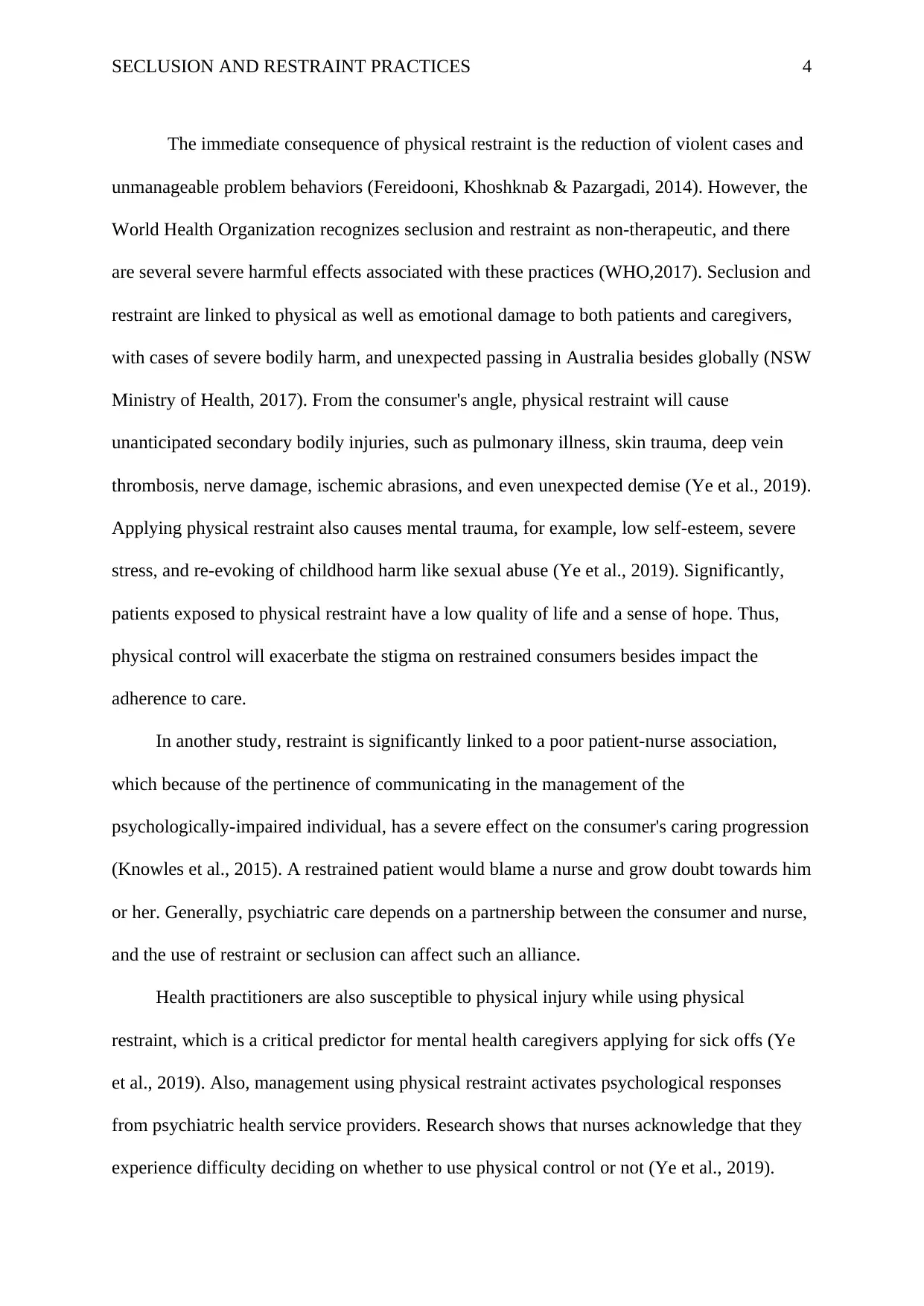
SECLUSION AND RESTRAINT PRACTICES 4
The immediate consequence of physical restraint is the reduction of violent cases and
unmanageable problem behaviors (Fereidooni, Khoshknab & Pazargadi, 2014). However, the
World Health Organization recognizes seclusion and restraint as non-therapeutic, and there
are several severe harmful effects associated with these practices (WHO,2017). Seclusion and
restraint are linked to physical as well as emotional damage to both patients and caregivers,
with cases of severe bodily harm, and unexpected passing in Australia besides globally (NSW
Ministry of Health, 2017). From the consumer's angle, physical restraint will cause
unanticipated secondary bodily injuries, such as pulmonary illness, skin trauma, deep vein
thrombosis, nerve damage, ischemic abrasions, and even unexpected demise (Ye et al., 2019).
Applying physical restraint also causes mental trauma, for example, low self-esteem, severe
stress, and re-evoking of childhood harm like sexual abuse (Ye et al., 2019). Significantly,
patients exposed to physical restraint have a low quality of life and a sense of hope. Thus,
physical control will exacerbate the stigma on restrained consumers besides impact the
adherence to care.
In another study, restraint is significantly linked to a poor patient-nurse association,
which because of the pertinence of communicating in the management of the
psychologically-impaired individual, has a severe effect on the consumer's caring progression
(Knowles et al., 2015). A restrained patient would blame a nurse and grow doubt towards him
or her. Generally, psychiatric care depends on a partnership between the consumer and nurse,
and the use of restraint or seclusion can affect such an alliance.
Health practitioners are also susceptible to physical injury while using physical
restraint, which is a critical predictor for mental health caregivers applying for sick offs (Ye
et al., 2019). Also, management using physical restraint activates psychological responses
from psychiatric health service providers. Research shows that nurses acknowledge that they
experience difficulty deciding on whether to use physical control or not (Ye et al., 2019).
The immediate consequence of physical restraint is the reduction of violent cases and
unmanageable problem behaviors (Fereidooni, Khoshknab & Pazargadi, 2014). However, the
World Health Organization recognizes seclusion and restraint as non-therapeutic, and there
are several severe harmful effects associated with these practices (WHO,2017). Seclusion and
restraint are linked to physical as well as emotional damage to both patients and caregivers,
with cases of severe bodily harm, and unexpected passing in Australia besides globally (NSW
Ministry of Health, 2017). From the consumer's angle, physical restraint will cause
unanticipated secondary bodily injuries, such as pulmonary illness, skin trauma, deep vein
thrombosis, nerve damage, ischemic abrasions, and even unexpected demise (Ye et al., 2019).
Applying physical restraint also causes mental trauma, for example, low self-esteem, severe
stress, and re-evoking of childhood harm like sexual abuse (Ye et al., 2019). Significantly,
patients exposed to physical restraint have a low quality of life and a sense of hope. Thus,
physical control will exacerbate the stigma on restrained consumers besides impact the
adherence to care.
In another study, restraint is significantly linked to a poor patient-nurse association,
which because of the pertinence of communicating in the management of the
psychologically-impaired individual, has a severe effect on the consumer's caring progression
(Knowles et al., 2015). A restrained patient would blame a nurse and grow doubt towards him
or her. Generally, psychiatric care depends on a partnership between the consumer and nurse,
and the use of restraint or seclusion can affect such an alliance.
Health practitioners are also susceptible to physical injury while using physical
restraint, which is a critical predictor for mental health caregivers applying for sick offs (Ye
et al., 2019). Also, management using physical restraint activates psychological responses
from psychiatric health service providers. Research shows that nurses acknowledge that they
experience difficulty deciding on whether to use physical control or not (Ye et al., 2019).
Secure Best Marks with AI Grader
Need help grading? Try our AI Grader for instant feedback on your assignments.
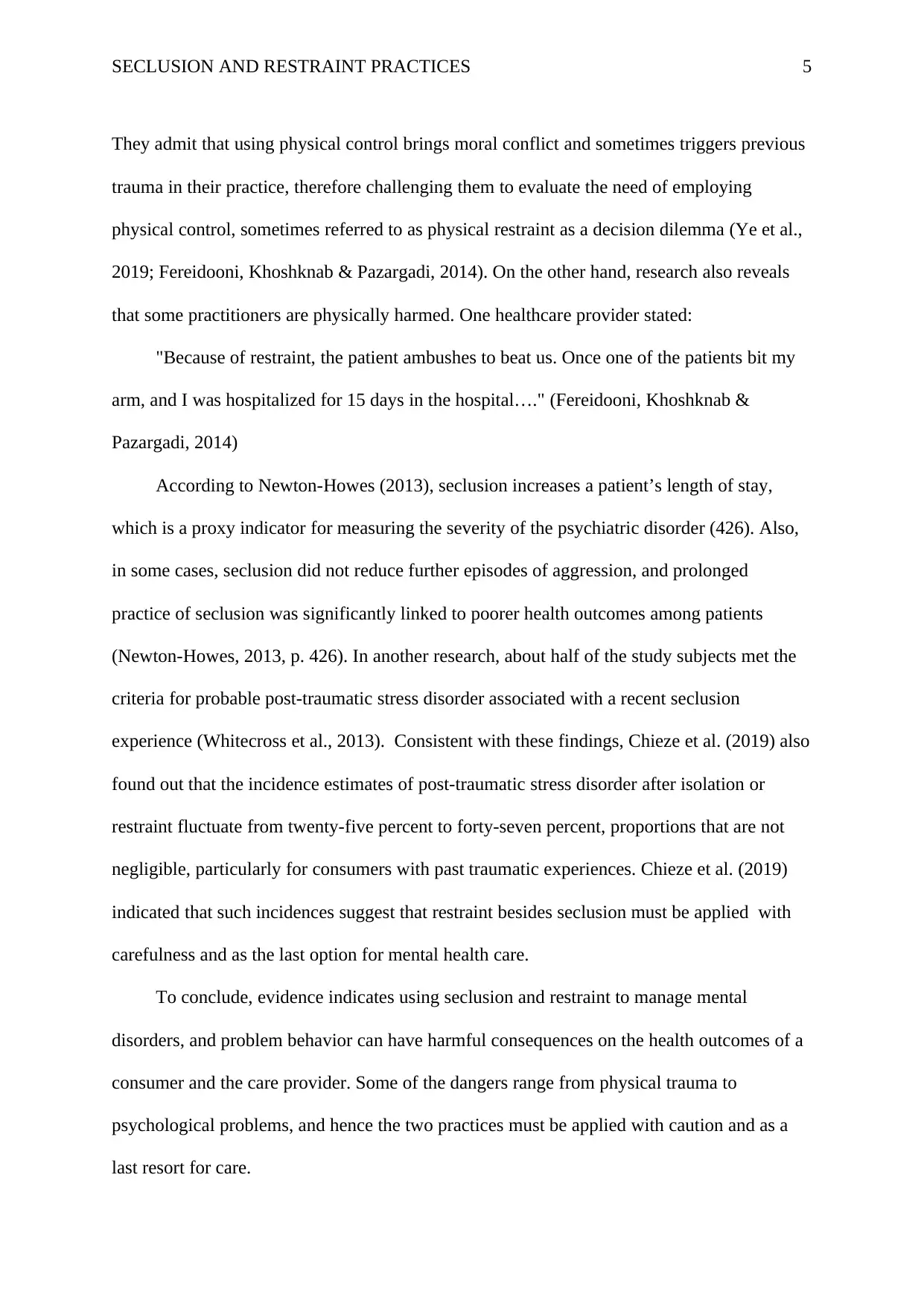
SECLUSION AND RESTRAINT PRACTICES 5
They admit that using physical control brings moral conflict and sometimes triggers previous
trauma in their practice, therefore challenging them to evaluate the need of employing
physical control, sometimes referred to as physical restraint as a decision dilemma (Ye et al.,
2019; Fereidooni, Khoshknab & Pazargadi, 2014). On the other hand, research also reveals
that some practitioners are physically harmed. One healthcare provider stated:
"Because of restraint, the patient ambushes to beat us. Once one of the patients bit my
arm, and I was hospitalized for 15 days in the hospital…." (Fereidooni, Khoshknab &
Pazargadi, 2014)
According to Newton-Howes (2013), seclusion increases a patient’s length of stay,
which is a proxy indicator for measuring the severity of the psychiatric disorder (426). Also,
in some cases, seclusion did not reduce further episodes of aggression, and prolonged
practice of seclusion was significantly linked to poorer health outcomes among patients
(Newton-Howes, 2013, p. 426). In another research, about half of the study subjects met the
criteria for probable post-traumatic stress disorder associated with a recent seclusion
experience (Whitecross et al., 2013). Consistent with these findings, Chieze et al. (2019) also
found out that the incidence estimates of post-traumatic stress disorder after isolation or
restraint fluctuate from twenty-five percent to forty-seven percent, proportions that are not
negligible, particularly for consumers with past traumatic experiences. Chieze et al. (2019)
indicated that such incidences suggest that restraint besides seclusion must be applied with
carefulness and as the last option for mental health care.
To conclude, evidence indicates using seclusion and restraint to manage mental
disorders, and problem behavior can have harmful consequences on the health outcomes of a
consumer and the care provider. Some of the dangers range from physical trauma to
psychological problems, and hence the two practices must be applied with caution and as a
last resort for care.
They admit that using physical control brings moral conflict and sometimes triggers previous
trauma in their practice, therefore challenging them to evaluate the need of employing
physical control, sometimes referred to as physical restraint as a decision dilemma (Ye et al.,
2019; Fereidooni, Khoshknab & Pazargadi, 2014). On the other hand, research also reveals
that some practitioners are physically harmed. One healthcare provider stated:
"Because of restraint, the patient ambushes to beat us. Once one of the patients bit my
arm, and I was hospitalized for 15 days in the hospital…." (Fereidooni, Khoshknab &
Pazargadi, 2014)
According to Newton-Howes (2013), seclusion increases a patient’s length of stay,
which is a proxy indicator for measuring the severity of the psychiatric disorder (426). Also,
in some cases, seclusion did not reduce further episodes of aggression, and prolonged
practice of seclusion was significantly linked to poorer health outcomes among patients
(Newton-Howes, 2013, p. 426). In another research, about half of the study subjects met the
criteria for probable post-traumatic stress disorder associated with a recent seclusion
experience (Whitecross et al., 2013). Consistent with these findings, Chieze et al. (2019) also
found out that the incidence estimates of post-traumatic stress disorder after isolation or
restraint fluctuate from twenty-five percent to forty-seven percent, proportions that are not
negligible, particularly for consumers with past traumatic experiences. Chieze et al. (2019)
indicated that such incidences suggest that restraint besides seclusion must be applied with
carefulness and as the last option for mental health care.
To conclude, evidence indicates using seclusion and restraint to manage mental
disorders, and problem behavior can have harmful consequences on the health outcomes of a
consumer and the care provider. Some of the dangers range from physical trauma to
psychological problems, and hence the two practices must be applied with caution and as a
last resort for care.

SECLUSION AND RESTRAINT PRACTICES 6
Registered Nurse-Consumers Collaboration in Minimizing Application of Seclusion and
Restraint
In Australia, the New South Wales state policy on aggressive tendencies, seclusion,
and restraint psychiatric facilities in New South Wales, for instance, requires that, after an
aggressive incidence, the nurse and the consumer must, through collaboration, review the
incident. The patient’s primary carer should also be present and contribute his or her thoughts
during the review, and the latter can include a chance to be involved in a post-incident
discourse with patient’s professional caregiver. The collaborative evaluation procedure is
intended to alleviate more incidences of seclusion as well as restraint besides work similarly
as the trauma-informed care and quality-improvement principles dictate (NSW Ministry of
Health, 2017).
Registered nurses (RNs) can help patients come up with a safety plan as a prevention
activity to reduce seclusion and restraint. Nurses collaborate with patients to aid assess and
recognize activators for hostile behaviors besides plans to treat or cool down the behavior
without deciding on the use to the two coercive interventions. A report by the NSW Ministry
of Health (2017) indicates that in public dialogue, patients explained that coercive
interventions were employed before they had a chance to participate in care preparation.
Although developing a safety plan can be challenging, particularly when someone has stress,
the activity can accompany other restraint as well as seclusion reduction methods, such as
activities and strategies for encouraging personal regulation, self-soothing as well as
reassurance. On the other hand, RNs can ensure individual care planning occurs in a more
orderly, reliable, and inclusive way with more participation of consumers, carers, and
community and inpatient teams. Throughout the planning phase, both the caregiver and
patients must actively participate, and the former should not just be a source of information.
Registered Nurse-Consumers Collaboration in Minimizing Application of Seclusion and
Restraint
In Australia, the New South Wales state policy on aggressive tendencies, seclusion,
and restraint psychiatric facilities in New South Wales, for instance, requires that, after an
aggressive incidence, the nurse and the consumer must, through collaboration, review the
incident. The patient’s primary carer should also be present and contribute his or her thoughts
during the review, and the latter can include a chance to be involved in a post-incident
discourse with patient’s professional caregiver. The collaborative evaluation procedure is
intended to alleviate more incidences of seclusion as well as restraint besides work similarly
as the trauma-informed care and quality-improvement principles dictate (NSW Ministry of
Health, 2017).
Registered nurses (RNs) can help patients come up with a safety plan as a prevention
activity to reduce seclusion and restraint. Nurses collaborate with patients to aid assess and
recognize activators for hostile behaviors besides plans to treat or cool down the behavior
without deciding on the use to the two coercive interventions. A report by the NSW Ministry
of Health (2017) indicates that in public dialogue, patients explained that coercive
interventions were employed before they had a chance to participate in care preparation.
Although developing a safety plan can be challenging, particularly when someone has stress,
the activity can accompany other restraint as well as seclusion reduction methods, such as
activities and strategies for encouraging personal regulation, self-soothing as well as
reassurance. On the other hand, RNs can ensure individual care planning occurs in a more
orderly, reliable, and inclusive way with more participation of consumers, carers, and
community and inpatient teams. Throughout the planning phase, both the caregiver and
patients must actively participate, and the former should not just be a source of information.
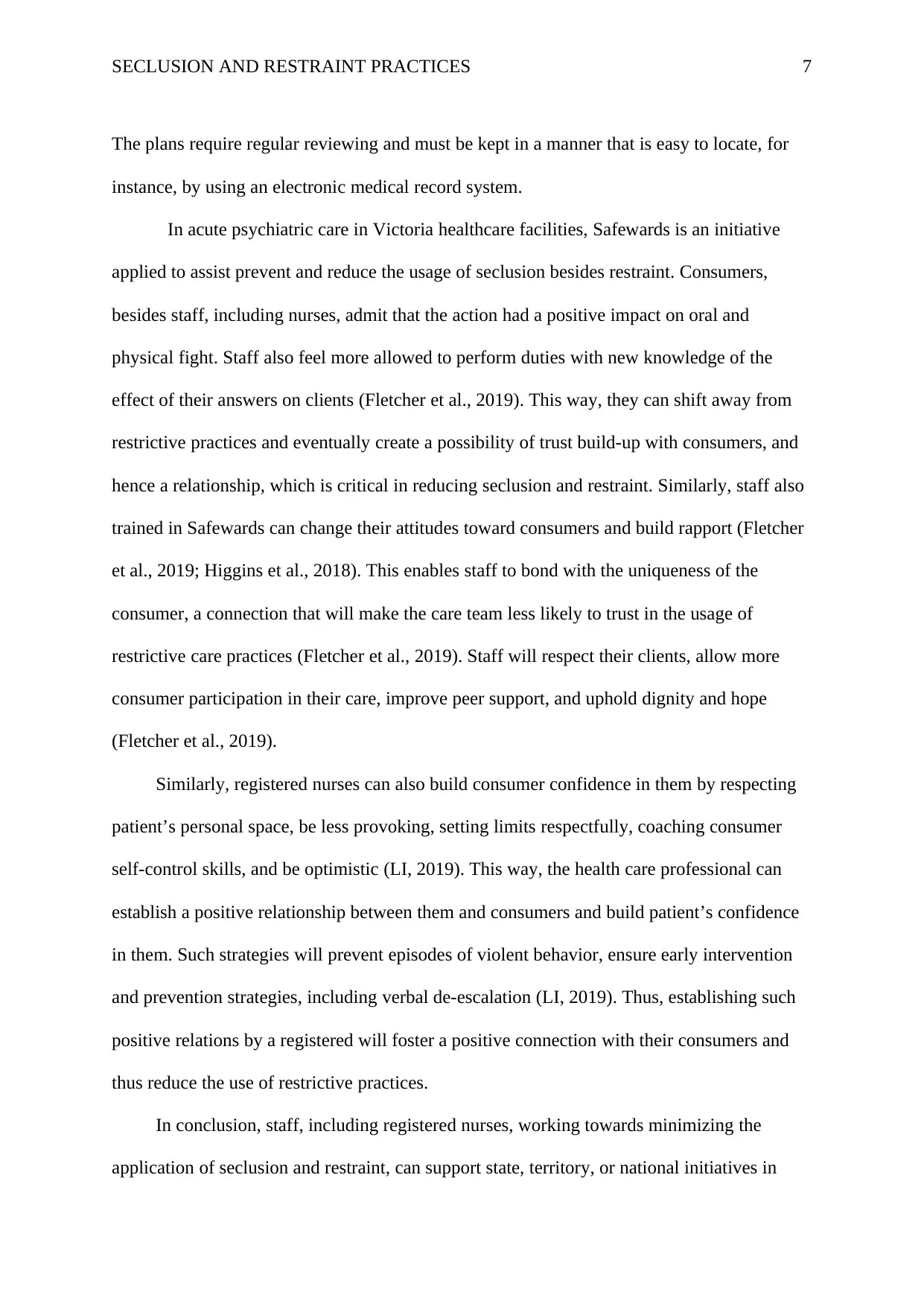
SECLUSION AND RESTRAINT PRACTICES 7
The plans require regular reviewing and must be kept in a manner that is easy to locate, for
instance, by using an electronic medical record system.
In acute psychiatric care in Victoria healthcare facilities, Safewards is an initiative
applied to assist prevent and reduce the usage of seclusion besides restraint. Consumers,
besides staff, including nurses, admit that the action had a positive impact on oral and
physical fight. Staff also feel more allowed to perform duties with new knowledge of the
effect of their answers on clients (Fletcher et al., 2019). This way, they can shift away from
restrictive practices and eventually create a possibility of trust build-up with consumers, and
hence a relationship, which is critical in reducing seclusion and restraint. Similarly, staff also
trained in Safewards can change their attitudes toward consumers and build rapport (Fletcher
et al., 2019; Higgins et al., 2018). This enables staff to bond with the uniqueness of the
consumer, a connection that will make the care team less likely to trust in the usage of
restrictive care practices (Fletcher et al., 2019). Staff will respect their clients, allow more
consumer participation in their care, improve peer support, and uphold dignity and hope
(Fletcher et al., 2019).
Similarly, registered nurses can also build consumer confidence in them by respecting
patient’s personal space, be less provoking, setting limits respectfully, coaching consumer
self-control skills, and be optimistic (LI, 2019). This way, the health care professional can
establish a positive relationship between them and consumers and build patient’s confidence
in them. Such strategies will prevent episodes of violent behavior, ensure early intervention
and prevention strategies, including verbal de-escalation (LI, 2019). Thus, establishing such
positive relations by a registered will foster a positive connection with their consumers and
thus reduce the use of restrictive practices.
In conclusion, staff, including registered nurses, working towards minimizing the
application of seclusion and restraint, can support state, territory, or national initiatives in
The plans require regular reviewing and must be kept in a manner that is easy to locate, for
instance, by using an electronic medical record system.
In acute psychiatric care in Victoria healthcare facilities, Safewards is an initiative
applied to assist prevent and reduce the usage of seclusion besides restraint. Consumers,
besides staff, including nurses, admit that the action had a positive impact on oral and
physical fight. Staff also feel more allowed to perform duties with new knowledge of the
effect of their answers on clients (Fletcher et al., 2019). This way, they can shift away from
restrictive practices and eventually create a possibility of trust build-up with consumers, and
hence a relationship, which is critical in reducing seclusion and restraint. Similarly, staff also
trained in Safewards can change their attitudes toward consumers and build rapport (Fletcher
et al., 2019; Higgins et al., 2018). This enables staff to bond with the uniqueness of the
consumer, a connection that will make the care team less likely to trust in the usage of
restrictive care practices (Fletcher et al., 2019). Staff will respect their clients, allow more
consumer participation in their care, improve peer support, and uphold dignity and hope
(Fletcher et al., 2019).
Similarly, registered nurses can also build consumer confidence in them by respecting
patient’s personal space, be less provoking, setting limits respectfully, coaching consumer
self-control skills, and be optimistic (LI, 2019). This way, the health care professional can
establish a positive relationship between them and consumers and build patient’s confidence
in them. Such strategies will prevent episodes of violent behavior, ensure early intervention
and prevention strategies, including verbal de-escalation (LI, 2019). Thus, establishing such
positive relations by a registered will foster a positive connection with their consumers and
thus reduce the use of restrictive practices.
In conclusion, staff, including registered nurses, working towards minimizing the
application of seclusion and restraint, can support state, territory, or national initiatives in
Paraphrase This Document
Need a fresh take? Get an instant paraphrase of this document with our AI Paraphraser
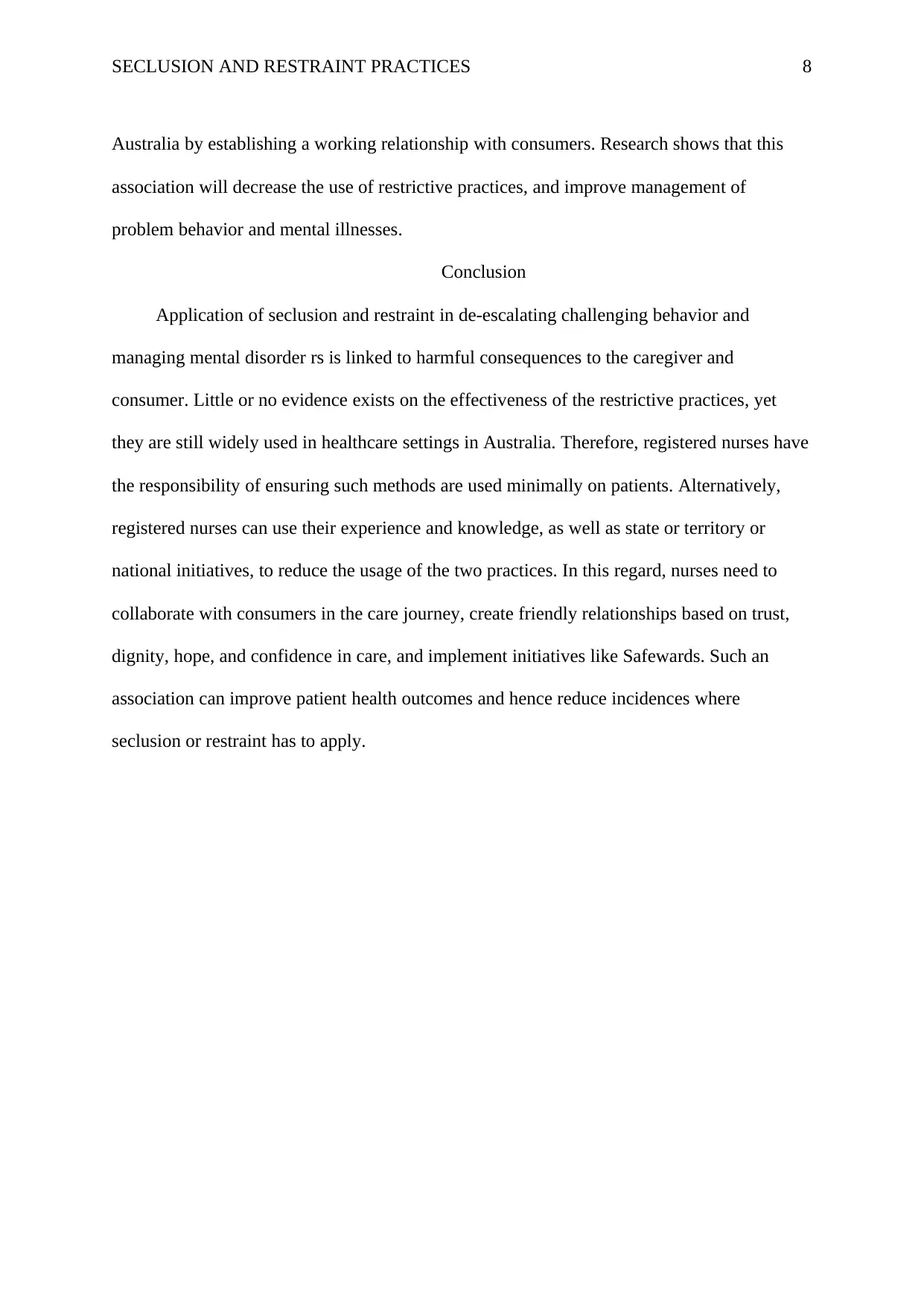
SECLUSION AND RESTRAINT PRACTICES 8
Australia by establishing a working relationship with consumers. Research shows that this
association will decrease the use of restrictive practices, and improve management of
problem behavior and mental illnesses.
Conclusion
Application of seclusion and restraint in de-escalating challenging behavior and
managing mental disorder rs is linked to harmful consequences to the caregiver and
consumer. Little or no evidence exists on the effectiveness of the restrictive practices, yet
they are still widely used in healthcare settings in Australia. Therefore, registered nurses have
the responsibility of ensuring such methods are used minimally on patients. Alternatively,
registered nurses can use their experience and knowledge, as well as state or territory or
national initiatives, to reduce the usage of the two practices. In this regard, nurses need to
collaborate with consumers in the care journey, create friendly relationships based on trust,
dignity, hope, and confidence in care, and implement initiatives like Safewards. Such an
association can improve patient health outcomes and hence reduce incidences where
seclusion or restraint has to apply.
Australia by establishing a working relationship with consumers. Research shows that this
association will decrease the use of restrictive practices, and improve management of
problem behavior and mental illnesses.
Conclusion
Application of seclusion and restraint in de-escalating challenging behavior and
managing mental disorder rs is linked to harmful consequences to the caregiver and
consumer. Little or no evidence exists on the effectiveness of the restrictive practices, yet
they are still widely used in healthcare settings in Australia. Therefore, registered nurses have
the responsibility of ensuring such methods are used minimally on patients. Alternatively,
registered nurses can use their experience and knowledge, as well as state or territory or
national initiatives, to reduce the usage of the two practices. In this regard, nurses need to
collaborate with consumers in the care journey, create friendly relationships based on trust,
dignity, hope, and confidence in care, and implement initiatives like Safewards. Such an
association can improve patient health outcomes and hence reduce incidences where
seclusion or restraint has to apply.

SECLUSION AND RESTRAINT PRACTICES 9
References
AIHW. (2020). Mental health services in Australia. Australian Institute of Health and
Welfare. Retrieved April 1, 2020, from https://www.aihw.gov.au/reports/mental-
health-services/mental-health-services-in-australia/report-contents/restrictive-
practices/seclusion
Brophy, L. M., Roper, C. E., Hamilton, B. E., Tellez, J. J., & McSherry, B. M. (2016).
Consumers and their supporters’ perspectives on poor practice and the use of seclusion
and restraint in mental health settings: Results from Australian focus groups.
International Journal of Mental Health Systems, 10(1).
https://doi.org/10.1186/s13033-016-0038-x
Chieze, M., Hurst, S., Kaiser, S., & Sentissi, O. (2019). Effects of seclusion and restraint in
adult psychiatry: A systematic review. Frontiers in Psychiatry, 10.
https://doi.org/10.3389/fpsyt.2019.00491
Fereidooni Moghadam, M., Fallahi Khoshknab, M., & Pazargadi, M. (2014). Psychiatric
Nurses' Perceptions about Physical Restraint; A Qualitative Study. International
journal of community-based nursing and midwifery, 2(1), 20–30.
Fletcher, J., Hamilton, B., Kinner, S. A., & Brophy, L. (2019). Safewards impact in inpatient
mental health units in Victoria, Australia: Staff perspectives. Frontiers in Psychiatry,
10. https://doi.org/10.3389/fpsyt.2019.00462
Hercelinskyj, G., & Alexander, L. (2019). Mental health nursing: Applying theory to
practice. Cengage AU.
Higgins, N., Meehan, T., Dart, N., Kilshaw, M., & Fawcett, L. (2018). Implementation of
the Safewards model in public mental health facilities: A qualitative evaluation of staff
perceptions. International Journal of Nursing Studies, 88, 114-120.
https://doi.org/10.1016/j.ijnurstu.2018.08.008
References
AIHW. (2020). Mental health services in Australia. Australian Institute of Health and
Welfare. Retrieved April 1, 2020, from https://www.aihw.gov.au/reports/mental-
health-services/mental-health-services-in-australia/report-contents/restrictive-
practices/seclusion
Brophy, L. M., Roper, C. E., Hamilton, B. E., Tellez, J. J., & McSherry, B. M. (2016).
Consumers and their supporters’ perspectives on poor practice and the use of seclusion
and restraint in mental health settings: Results from Australian focus groups.
International Journal of Mental Health Systems, 10(1).
https://doi.org/10.1186/s13033-016-0038-x
Chieze, M., Hurst, S., Kaiser, S., & Sentissi, O. (2019). Effects of seclusion and restraint in
adult psychiatry: A systematic review. Frontiers in Psychiatry, 10.
https://doi.org/10.3389/fpsyt.2019.00491
Fereidooni Moghadam, M., Fallahi Khoshknab, M., & Pazargadi, M. (2014). Psychiatric
Nurses' Perceptions about Physical Restraint; A Qualitative Study. International
journal of community-based nursing and midwifery, 2(1), 20–30.
Fletcher, J., Hamilton, B., Kinner, S. A., & Brophy, L. (2019). Safewards impact in inpatient
mental health units in Victoria, Australia: Staff perspectives. Frontiers in Psychiatry,
10. https://doi.org/10.3389/fpsyt.2019.00462
Hercelinskyj, G., & Alexander, L. (2019). Mental health nursing: Applying theory to
practice. Cengage AU.
Higgins, N., Meehan, T., Dart, N., Kilshaw, M., & Fawcett, L. (2018). Implementation of
the Safewards model in public mental health facilities: A qualitative evaluation of staff
perceptions. International Journal of Nursing Studies, 88, 114-120.
https://doi.org/10.1016/j.ijnurstu.2018.08.008

SECLUSION AND RESTRAINT PRACTICES 10
Knowles, S. F., Hearne, J., & Smith, I. (2015). Physical restraint and the therapeutic
relationship. The Journal of Forensic Psychiatry & Psychology, 26(4), 461-475.
https://doi.org/10.1080/14789949.2015.1034752
Knox, D., & Holloman, G. (2012). Use and avoidance of seclusion and restraint: consensus
statement of the American Association for emergency psychiatry project BETA
seclusion and restraint Workgroup. Western Journal of Emergency Medicine, 13(1),
35-40. https://doi.org/10.5811/westjem.2011.9.6867
LI, J. (2019). A nursing perspective on seclusion in Australia’s mental health system.
Biomedical Journal of Scientific & Technical Research, 18(1).
https://doi.org/10.26717/bjstr.2019.18.003089
Newton-Howes, G. (2013). Use of seclusion for managing behavioral disturbance in
patients. Advances in Psychiatric Treatment, 19(6), 422-428.
https://doi.org/10.1192/apt.bp.112.011114
NSW Ministry of Health. (2017). Review of seclusion, restraint, and observation of
consumers with a mental illness in NSW Health facilities. NSW Health.
https://www.health.nsw.gov.au/mentalhealth/reviews/seclusionprevention/
Documents/report-seclusion-restraint-observation.pdf
RANZCP. (2016). Minimizing the use of seclusion and restraint in people with mental
illness. Royal Australian and New Zealand College of Psychiatrists | RANZCP.
https://www.ranzcp.org/news-policy/policy-and-advocacy/position-statements/
minimising-the-use-of-seclusion-and-restraint-in-p
Raveesh, B. N., Gowda, G. S., & Gowda, M. (2019). Alternatives to use of restraint: A path
toward humanistic care. Indian journal of psychiatry, 61(Suppl 4), S693–S697.
https://doi.org/10.4103/psychiatry.IndianJPsychiatry_104_19
Knowles, S. F., Hearne, J., & Smith, I. (2015). Physical restraint and the therapeutic
relationship. The Journal of Forensic Psychiatry & Psychology, 26(4), 461-475.
https://doi.org/10.1080/14789949.2015.1034752
Knox, D., & Holloman, G. (2012). Use and avoidance of seclusion and restraint: consensus
statement of the American Association for emergency psychiatry project BETA
seclusion and restraint Workgroup. Western Journal of Emergency Medicine, 13(1),
35-40. https://doi.org/10.5811/westjem.2011.9.6867
LI, J. (2019). A nursing perspective on seclusion in Australia’s mental health system.
Biomedical Journal of Scientific & Technical Research, 18(1).
https://doi.org/10.26717/bjstr.2019.18.003089
Newton-Howes, G. (2013). Use of seclusion for managing behavioral disturbance in
patients. Advances in Psychiatric Treatment, 19(6), 422-428.
https://doi.org/10.1192/apt.bp.112.011114
NSW Ministry of Health. (2017). Review of seclusion, restraint, and observation of
consumers with a mental illness in NSW Health facilities. NSW Health.
https://www.health.nsw.gov.au/mentalhealth/reviews/seclusionprevention/
Documents/report-seclusion-restraint-observation.pdf
RANZCP. (2016). Minimizing the use of seclusion and restraint in people with mental
illness. Royal Australian and New Zealand College of Psychiatrists | RANZCP.
https://www.ranzcp.org/news-policy/policy-and-advocacy/position-statements/
minimising-the-use-of-seclusion-and-restraint-in-p
Raveesh, B. N., Gowda, G. S., & Gowda, M. (2019). Alternatives to use of restraint: A path
toward humanistic care. Indian journal of psychiatry, 61(Suppl 4), S693–S697.
https://doi.org/10.4103/psychiatry.IndianJPsychiatry_104_19
Secure Best Marks with AI Grader
Need help grading? Try our AI Grader for instant feedback on your assignments.
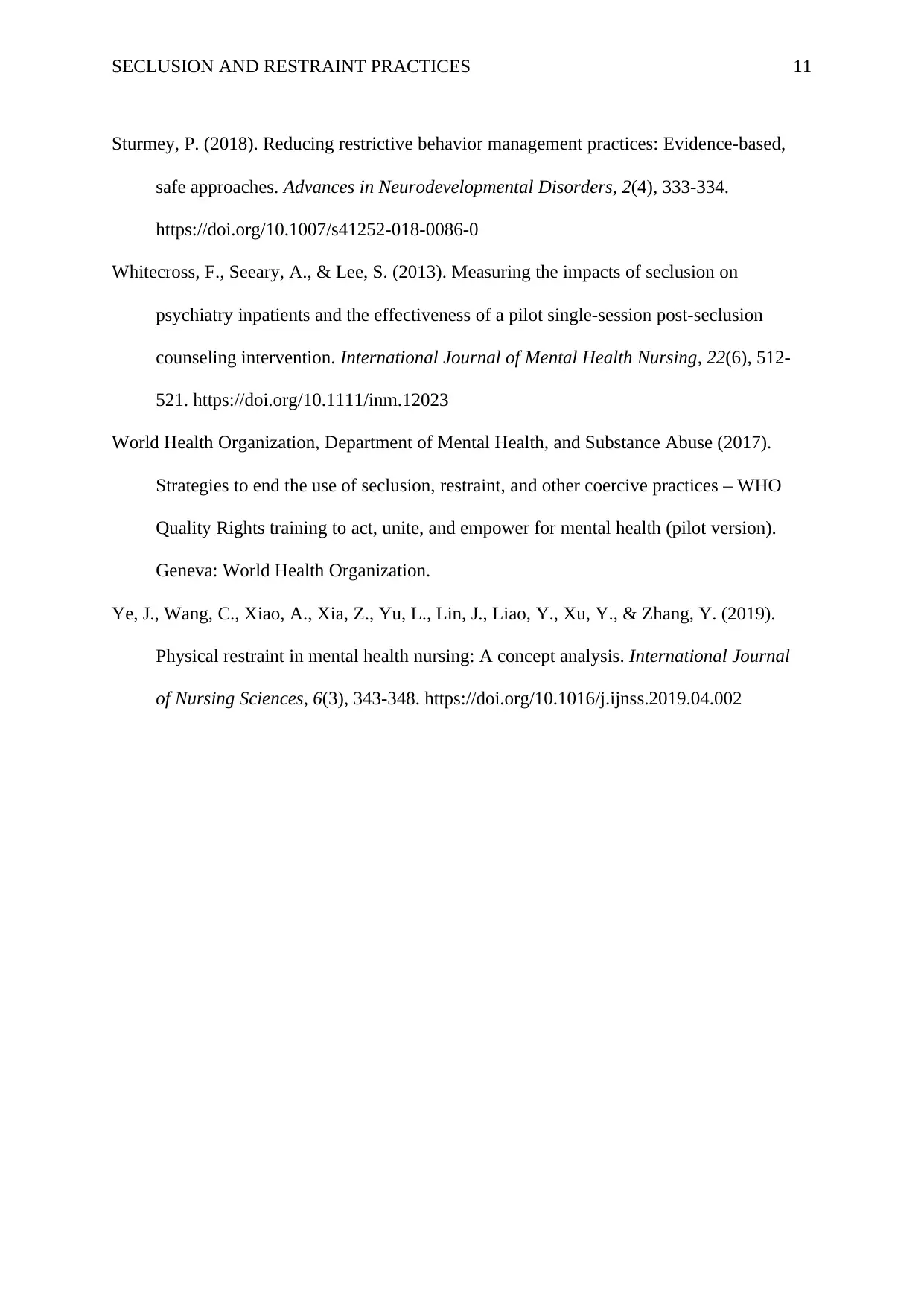
SECLUSION AND RESTRAINT PRACTICES 11
Sturmey, P. (2018). Reducing restrictive behavior management practices: Evidence-based,
safe approaches. Advances in Neurodevelopmental Disorders, 2(4), 333-334.
https://doi.org/10.1007/s41252-018-0086-0
Whitecross, F., Seeary, A., & Lee, S. (2013). Measuring the impacts of seclusion on
psychiatry inpatients and the effectiveness of a pilot single-session post-seclusion
counseling intervention. International Journal of Mental Health Nursing, 22(6), 512-
521. https://doi.org/10.1111/inm.12023
World Health Organization, Department of Mental Health, and Substance Abuse (2017).
Strategies to end the use of seclusion, restraint, and other coercive practices – WHO
Quality Rights training to act, unite, and empower for mental health (pilot version).
Geneva: World Health Organization.
Ye, J., Wang, C., Xiao, A., Xia, Z., Yu, L., Lin, J., Liao, Y., Xu, Y., & Zhang, Y. (2019).
Physical restraint in mental health nursing: A concept analysis. International Journal
of Nursing Sciences, 6(3), 343-348. https://doi.org/10.1016/j.ijnss.2019.04.002
Sturmey, P. (2018). Reducing restrictive behavior management practices: Evidence-based,
safe approaches. Advances in Neurodevelopmental Disorders, 2(4), 333-334.
https://doi.org/10.1007/s41252-018-0086-0
Whitecross, F., Seeary, A., & Lee, S. (2013). Measuring the impacts of seclusion on
psychiatry inpatients and the effectiveness of a pilot single-session post-seclusion
counseling intervention. International Journal of Mental Health Nursing, 22(6), 512-
521. https://doi.org/10.1111/inm.12023
World Health Organization, Department of Mental Health, and Substance Abuse (2017).
Strategies to end the use of seclusion, restraint, and other coercive practices – WHO
Quality Rights training to act, unite, and empower for mental health (pilot version).
Geneva: World Health Organization.
Ye, J., Wang, C., Xiao, A., Xia, Z., Yu, L., Lin, J., Liao, Y., Xu, Y., & Zhang, Y. (2019).
Physical restraint in mental health nursing: A concept analysis. International Journal
of Nursing Sciences, 6(3), 343-348. https://doi.org/10.1016/j.ijnss.2019.04.002
1 out of 11
Related Documents
Your All-in-One AI-Powered Toolkit for Academic Success.
+13062052269
info@desklib.com
Available 24*7 on WhatsApp / Email
![[object Object]](/_next/static/media/star-bottom.7253800d.svg)
Unlock your academic potential
© 2024 | Zucol Services PVT LTD | All rights reserved.





